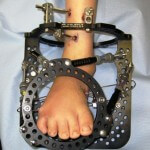I am interested in the correction of deformity of the limbs in both children and adults. Such deformities are caused by a wide range of conditions. Limb deformity can be corrected by several surgical methods including;
- Â Osteotomy (cutting of bone) with internal fixation by plates / screws / nails
- Â Osteotomy and lengthening of bone with an external device, including;
- Ilizarov Frame
- Taylor Spatial Frame
- Orthofix Limb reconstruction system
- Osteotomy and lengthening with an internal device- Precice Nail -https://www.nuvasive.com/procedures/limb-lengthening/precice-system/#:~:text=The%20PRECICE%C2%AE%20System%20is%20composed%20of%20implantable%20nails,to%20securely%20fix%20the%20device%20are%20not%20eligible.
- Guided growth in children( epiphysiodesis or hemiepiphysiodesis)
Limb Deformity/Leg Length Discrepancy
Introduction
There are many different conditions in childhood and adult life that can lead to deformity of a limb or difference in leg lengths. Treatment for these conditions depends on the condition being treated, the age of the child and the amount of deformity or shortening. Generally, only a final difference of leg length of 2cm or more requires surgical treatment. An outline of treatment options is given below.
Orthotics / Prosthetics
A leg length discrepancy can be treated with insoles and / or a shoe raise. Orthotics can be used as a temporary or permanent treatment. For other conditions, a prosthetic or false limb can be used to restore function.
Epiphysiodesis
This is a surgical option designed to slow down the growth of the long leg over a period of months to years. It is only used in growing children. The operation involves a general anaesthetic. Small incisions are made around the knee near the growth plates of the thigh bone and the shin bone. The growth plates are prevented from growing by the use of small screws and plates (â8 â platesâ). The screws are buried beneath the skin and are not visible. Stitches are buried beneath the skin and do not need to be removed. The child is normally in hospital for 2-3 days. The child can weight bear immediately and return back to normal activity within a few weeks. Long term follow up is required to monitor the effects of the surgery. The timing of the surgery is based on the amount of growth predicted for the child. Therefore, this procedure can under- and over-correct the difference in leg length. Occasionally the screws have to be removed to allow growth to continue.
This procedure can be used on one half of the growth plate to correct deformity in a limb e.g. knock-knees or bow legs. This is known as hemiepiphysiodesis.
Complications
The procedure results in small scars around the knee. There is a small risk of infection although this is rarely a serious problem in children. There is a small risk of injuring nerves and blood vessels around the knee. The procedure can result in under- or over- correction of leg length difference, or angulation of the limb. Further surgery can be required in this case.
Ilizarov / Taylor Spatial Frame
Limb deformity or leg length problems can be treated by applying an external frame to the leg. The frame consists of metal rings which go round the limb. The rings are held onto the body by wires and metal pins which pass through the skin and are anchored into the bone. During this operation, the bone is divided. Gradual adjustment of the frame results in creation of a new bone allowing a limb to be lengthened. The procedure involves the child having an anaesthetic. The child is normally in hospital for one week. The child and family are encouraged to clean pin sites around the limb. The adjustments of the frame (distractions) are performed by the child and/or family. The child is normally encouraged to walk on the operated limb and to actively exercise the joints above and below the frame. The child is normally reviewed on a weekly basis in clinic to monitor the correction of the deformity. The frame normally remains in place for 3 months up to one year depending on the condition which is being treated. The frame is normally removed under a general anaesthetic at the end of treatment.
Complications
Limb lengthening is a specialised and complex procedure. Complications from surgery are common, but most are relatively minor. The complications are listed below.
Pin Tract Infection.
This is very common. It is treated by cleaning the skin around the pin. Occasionally antibiotics are required. If pin infections are troublesome, the pins can be removed.
Scars.
There are numerous small scars around the limb when a frame is applied. During the lengthening process, these scars can stretch out.
Injury to nerves and blood vessels.
There is a small risk of injuring nerves and blood vessels when the frame is applied. During a lengthening procedure, nerves can be stretched and can produce weakness and numbness in the limb. In that case lengthening is slowed down or occasionally it has to be stopped short of the expected lengthening because of nerve problems.
Joint stiffness.
Joints above and below the frame can become stiff because of tension in the soft tissues as the frame is lengthened. This stiffness requires physiotherapy. It generally improves when the frame is removed but may take several months. Occasionally full movement is not regained in the joint.
Problems with new bone formation when lengthening a limb.
The new bone form can be slow to mature into a strong bone. This can mean the frame stays on for a longer period of time than anticipated. Occasionally when the frame is removed the newly formed bone can break or bend and this may require further surgery.
 Internal Bone Lengthener
When the growth plates have fused ( approx 14yrs for a girl, 16yrs for a boy) it can be possible to lengthen the bone with an internal device. This means that no external frame is required, which is more comfortable for the patient. Rehabilitation is also easier. The device used is called a precice nail
Complications
The same complications of nerve and vessel injury and problems with new bone formation can also occur. The scars are less obvious than with a frame, and the joints are less stiff.
With the Precice nail, the bone can lengthen too quickly or too slowly, which may require hospital treatment or further surgery.

